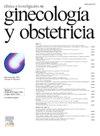Development of a gynecological robotic surgery program with the Da Vinci system: Beginnings and consolidation
IF 0.1
Q4 OBSTETRICS & GYNECOLOGY
Clinica e Investigacion en Ginecologia y Obstetricia
Pub Date : 2025-04-17
DOI:10.1016/j.gine.2025.101035
引用次数: 0
Abstract
Aims
This study aimed to evaluate the operative time, hospital stay and complications in patients undergoing robotic gynaecological surgery before and after completing the surgical team's learning curve.
Methods
Observational retrospective study that included 185 patients who underwent Da Vinci robot-assisted gynaecological surgery from January 2013 to December 2021 at the Gynaecology and Obstetrics Department of the Rey Juan Carlos University Hospital (Spain). The sample was divided into two groups: those conducted before and after the completion of the established learning curve, set at 35 procedures per surgeon.
Results
During the study period, 185 patients underwent robot-assisted gynaecological surgery, 77 (41.6%) during period one and 108 (58.4%) during period two after. The median reduction in operative time was 43 min (95% CI 17–70) in period two compared to period one. The median length of hospital stay was two days (IQR = 2–3) and one day (IQR = 1–2) (p = 0.001) respectively. There were no statistically significant differences in transfusion rates, complications, and readmissions.
Conclusions
Completing the learning curve significantly reduced the operative time and hospital stay. While there were fewer complications during the second period, these differences were not statistically significant.
发展与达芬奇系统妇科机器人手术程序:开始和巩固
目的本研究旨在评估机器人妇科手术患者在完成手术团队学习曲线前后的手术时间、住院时间和并发症。方法对2013年1月至2021年12月在西班牙雷胡安卡洛斯大学医院妇产科接受达芬奇机器人辅助妇科手术的185例患者进行观察性回顾性研究。样本被分为两组:在完成既定学习曲线之前和之后进行的,设定为每位外科医生35次手术。结果在研究期间,185例患者接受了机器人辅助妇科手术,其中第一期77例(41.6%),第二期108例(58.4%)。与第一阶段相比,第二阶段的中位手术时间减少了43分钟(95% CI 17-70)。中位住院时间分别为2天(IQR = 2 ~ 3)和1天(IQR = 1 ~ 2) (p = 0.001)。在输血率、并发症和再入院方面没有统计学上的显著差异。结论完成学习曲线可显著缩短手术时间和住院时间。第二阶段并发症发生率较低,但差异无统计学意义。
本文章由计算机程序翻译,如有差异,请以英文原文为准。
求助全文
约1分钟内获得全文
求助全文
来源期刊

Clinica e Investigacion en Ginecologia y Obstetricia
OBSTETRICS & GYNECOLOGY-
CiteScore
0.20
自引率
0.00%
发文量
54
期刊介绍:
Una excelente publicación para mantenerse al día en los temas de máximo interés de la ginecología de vanguardia. Resulta idónea tanto para el especialista en ginecología, como en obstetricia o en pediatría, y está presente en los más prestigiosos índices de referencia en medicina.
 求助内容:
求助内容: 应助结果提醒方式:
应助结果提醒方式:


